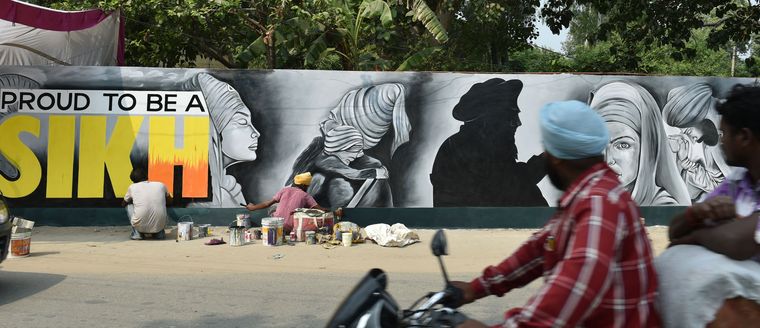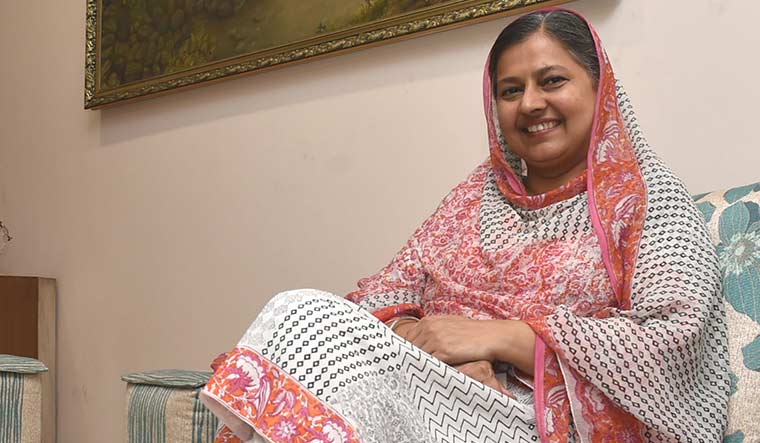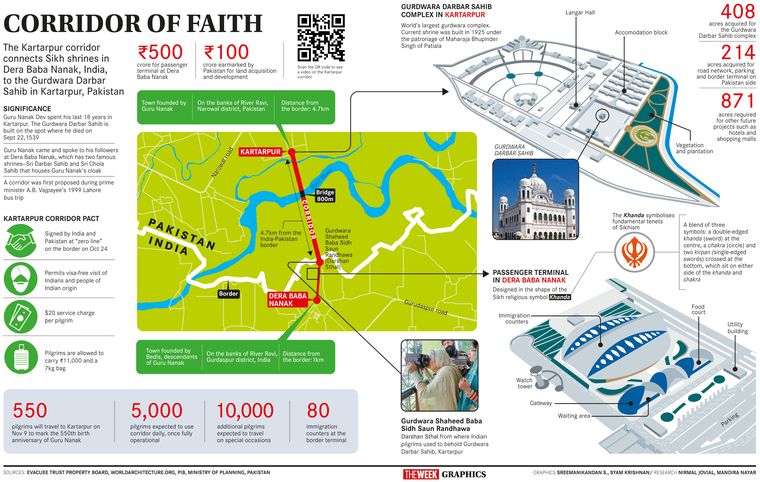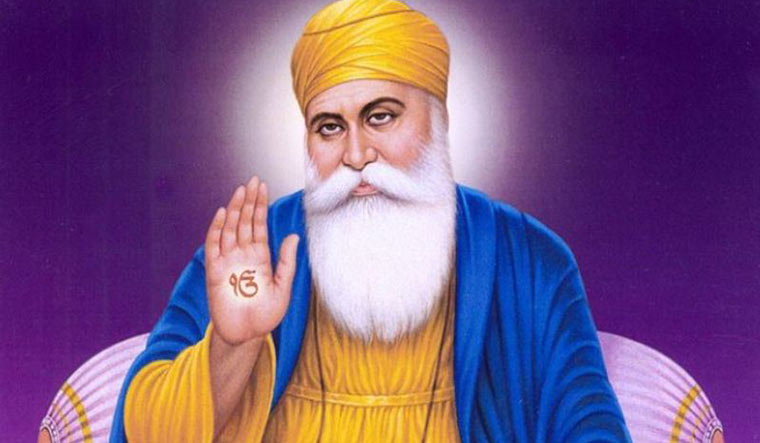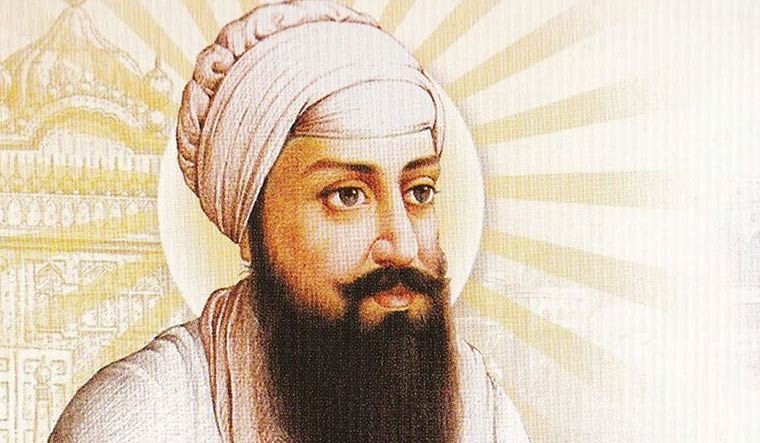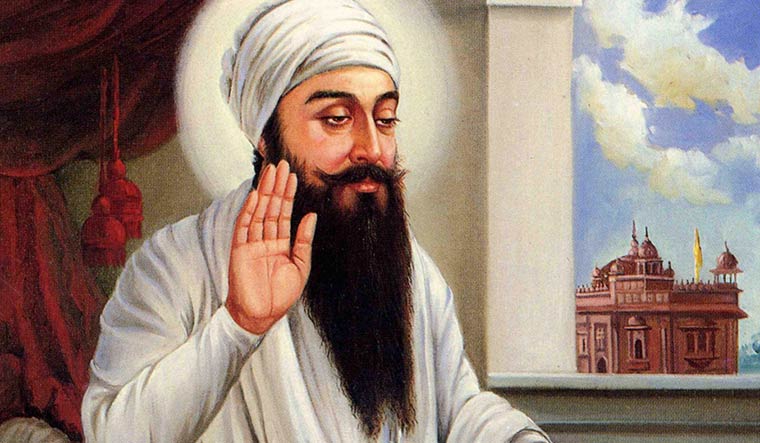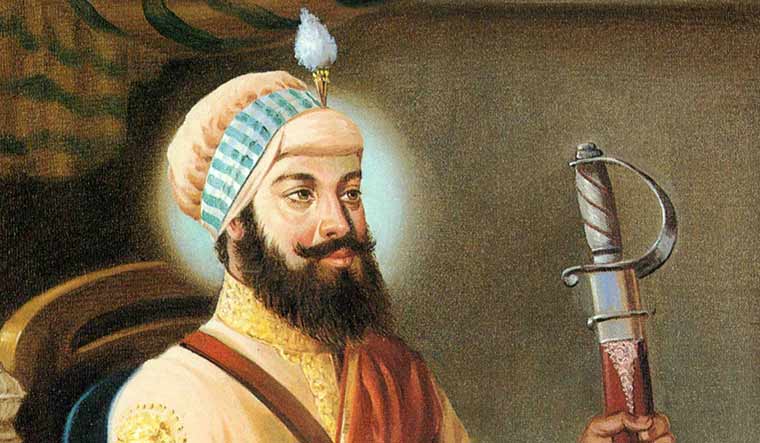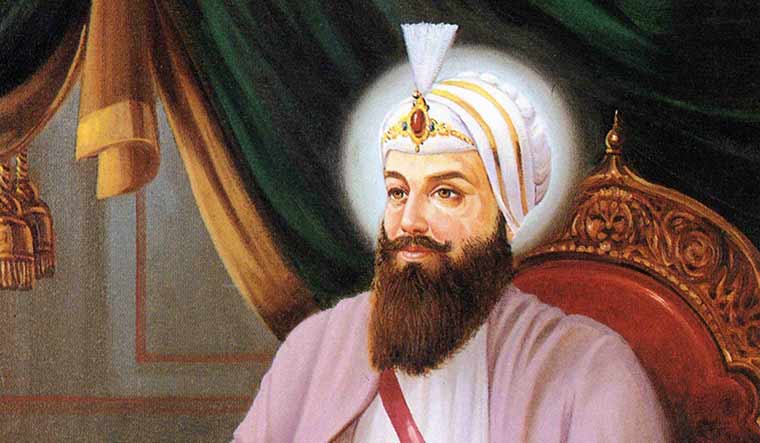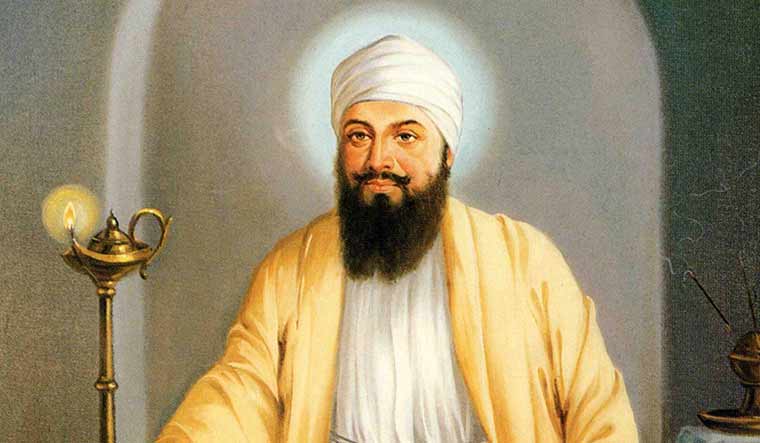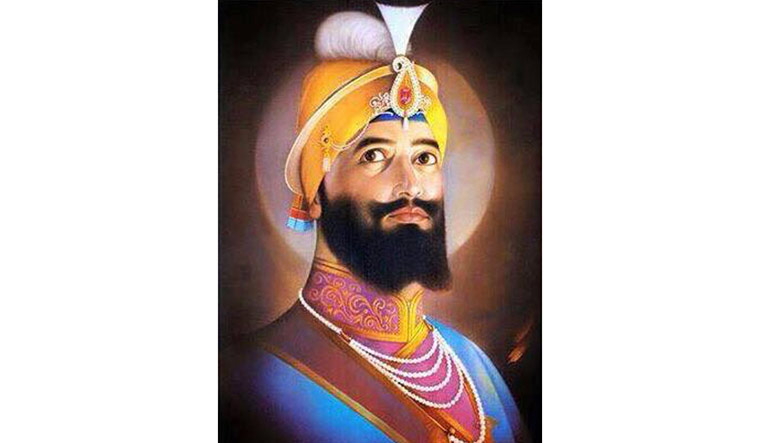The black floor is dusted white. Bags of flour lie in a corner. The smell of fresh rotis fills the air. A mixer pummels flour into dough and splutters constantly in the background. Across the room, a conveyor belt plops out assembly-line rotis. Sitting next to it, in the sweltering heat, are women, punctuating each breath with a heartfelt Waheguru, adding shine to the hot-off-the-shelves rotis with dollops of ghee.
Faith moves mountains. In the langar [community kitchen] at the Harmandir Sahib, also known as the Darbar Sahib or the Golden Temple, it moves rotis. The langar was started by Guru Nanak Dev to break the caste barrier; it is open 24 hours and everyone is welcome. But mountains often require just a one-time Herculean effort, a grand gesture of devotion, but moving a chapati round the clock requires constant devotion. But it is simple, guided by, as Nanak said, sarbat da bhala (welfare of all) and seva (service).
These two planks lie at the heart of India’s youngest religion. And, in Punjab, they are always on display. Across the state, nothing is in small measures. Roadside dhabas serve parathas as large as dinner plates. Lassi glasses are always gigantic and brimming over. And, hospitality is more often over the top. If you do not want the machine-made rotis, there are hand-fluffed ones available—all you need to do is ask. Even rice, which is not on the menu of a langar, will appear, again in a bowl spilling over, should you ask.
Nanak’s teachings—vand chhakko (to share with others), naam japo (meditate on God’s name) and kirt karo (do work)—are reflected in the daily lives of the Sikhs. And, 550 years after his birth, his message has captured the world. His followers have grown exponentially to make Sikhism the fifth largest religion in the world. Gurdwaras now dot the world, from Punjab to Poland—there was a petition to start one in China, too. His birth anniversary this November 12 is being celebrated across continents. Nepal has brought out commemorative coins; in Pakistan, where he was born and died, a tent city is coming up in Nankana Sahib; in India, where the largest number of Sikhs live, it will be bigger than any Diwali ever. Also, there is the anniversary official app, which will have his bani (teachings).
Nanak was more than just a founder of a new religion. He was also a walker—he spent 24 years travelling the world, walking over 25,000km across countries. He left his family to spread his message, converse and expand his mind. “He crossed over Leh on foot,” says artist Arpana Caur, who has had the opportunity to go to many places that Nanak did. “It is such a narrow path. I went in the Army car with a doctor and an oxygen tank.” The journey is impossible to make even now. Ask Amardeep Singh, a historian who is retracing Nanak’s footsteps for a documentary. “Seventy per cent of the area he travelled to is now in a conflict zone,” says Amardeep, who has published two books on gurdwaras left behind in Pakistan. Accompanied by his companion Mardana and a rabab, Nanak always travelled with music.
Nanak attained enlightenment after taking a dip in the Kali Bein river in Punjab. “Na koi Hindu, na koi Musalman (There is no Hindu or Muslim),” were the first words he spoke when he emerged three days later from the river. It is this message of tolerance—one even more important today—that needs to be clung on to. “He was a man of peace,’’ says Jaswinder Singh Jassi, information officer, Shiromani Gurdwara Parbandhak Committee (SGPC). This philosophy lies at the heart of Punjabiat, a word that embodies the plurality of the Punjab. And, Nanak is the pioneer of this spirit. “It is famously said, Nanak Shah Fakir, Hindu aur Sikhon da Guru, Musalmanon da Pir [Nanak is the spiritual leader of Hindus and Sikhs and a saint of the Muslims]. He was a nation builder,” says Jassi.
What makes his message remarkable is the context in which he emerged. It was an age of divisiveness. “The [dark] age is like a knife. Kings are butchers. Religion has taken wings and flown. In the dark night of falsehood, I cannot see where the moon of truth is rising,’’ he writes. Today, in another age of darkness, his message is still revolutionary.
He left Sultanpur Lodhi to travel the world, from Mecca to Nepal, Iran and Afghanistan, spreading his message of oneness. It reflected in his life, too. Mardana, who added music to his words, was a Muslim. Even now, in Punjab across the border, Nanak’s shrines are visited by not only Sikhs but also Muslims. “It would be narrow to look at Nanak only through the prism of Sikhism,’’ says writer Amandeep Sandhu. “There are 2.5 crore Sikhs. But there would be 12 crore Nanak panthis [followers]. What gives the community the right to appropriate his legacy?”
In Pakistan, Nanak still lives on. His gurdwaras may not be thronged, but his tradition of the langar is continued by his Muslim followers. His wanderlust is embedded in the DNA of all of Punjab. The story goes thus: Nanak was passing through a village that treated him with respect. When he left, he blessed them to flourish. At the next village, Nanak told the villagers: “Uproot yourself.” When a villager asked him why he wanted them to scatter, he said: “Goodness must travel.” Plastered across Punjab, looming over the endless lime-green fields of paddy, are boards that advertise dreams of living abroad. Nanak’s followers can be found in every outpost of the world, blending in to become part of the community and always giving back.
But this sense of service goes deeper. The community has let it colour every aspect of life. In sports, they have brought laurels by pushing the limits. In World War I, it was the Sikhs who stood out with their turbans when they went to serve in freezing Flanders. One of the first community kitchens to be set up in war-torn Syria was by Khalsa Aid. “We were the first to arrive in Gujarat [after the earthquake],” says Roop Singh, chief secretary of SGPC. “The aftershocks were still being felt. In Nepal, we were the first, as we were in Kashmir.”
The 550th birth anniversary is a watershed moment for the community. For Punjab, it is a time to reflect. Once the food creator of the country, it has overused its resources. Owing to a falling water table, high fertiliser costs and increased indebtedness, farmer suicides are common. “I cannot imagine anyone ever escaping the circle,” says Santosh Singh, a farmer from Tarn Taran Sahib, who is in Sultanpur Lodhi to do seva. Then there is drugs, corruption, the skewed sex ratio and joblessness in Punjab. “The corruption has hollowed us out like termites,” says Santosh. “It is only the gurdwaras that is keeping it together.”
The solution to the crisis also lies at Nanak’s doors, in his love for nature. “Nanak was a man who was inspired by nature,” says Sandhu. “This anniversary should have been a chance to get his people to look at reviving agriculture.” Nanak kheti or organic farming might be the way out. But it is not easy. In Dhaliwal village, Gurdev Singh is the only farmer who has resisted the opposition from his family to go natural. “For the first year, I got practically nothing,” he says. But he kept at it. “The land is poison,” he says. “When I was growing up, we could drink water straight from the farm. Now, no one ever does. How can we keep doing this?” Gurdev is not the only one in his village who refuses to burn stubble; his uncle has joined him this year. “There is a famous story about Guru Nanak. His father sent him out to look after the fields. Nanak, instead of chasing away the birds, encouraged them to eat, telling them this was theirs. Nanak kheti advocates no violence,” says Umendra Dutt of the Kheti Virasat Mission that advocates organic farming.
But the question of identity, in fractured times of hindutva, looms large. In a gurdwara in Delhi, young boys stand in front of mirrors carefully winding turbans around their heads. Gurjeet Singh, 24, in a 3D version of a turban with each pleat so sharp that it stands out, is guiding a teenager. “It takes over 45 minutes to an hour to tie a turban in the way I have,” he says. Children are natural mimics, says Manmeet Singh, who is part of the Akaal Purakh Ki Fauj (APF), a group of young Sikhs raising awareness about Sikh history and culture. “They might not be willing to listen to you, but if you do it, they will want to imitate you,” he says.
The dastar or the turban has always been referred to as the crown of the Sikhs. Many battles have been fought legally. Ishpreet Singh of APF, however, says, “Now people do not want to stand out. People now wear caps from the APF. But the Guru Granth Sahib mentions clearly that if you do not wear a turban, you will be plagued with boils.’’
Turban tying classes are now advertised across gurdwaras. A poster greets you even outside the langar hall at the Golden Temple. In Amritsar, there are shops that open at the crack of dawn for office-goers who do not know how to tie a turban. “Earlier you were taught how to tie a turban by your father. The first time you wear it is in the gurdwara. But now this tradition is not as common,” says Ishpreet. “Seventy per cent of Sikhs in Punjab cut their hair, In Delhi, it is 30 per cent. But in Nanded you will hardly ever see a Sikh who has cut his hair.” The reasons are many, from lack of time to the hot weather. “But these are only excuses,” he says. Dig deeper, and it points to a sense of alienation. The ghosts of Operation Blue Star and the 1984 riots continue to haunt the community. “Cutting of the hair is symbolic,” says Mejindarpal Kaur, international legal director, United Sikhs, an NGO. With the emphasis on being distinct even physically, the cutting of hair or even trimming of a beard becomes sensitive. Kaur, who is Malaysian, always referred to India as desh. But after 1984, there was a betrayal. If the Sikh diaspora felt it so strongly, it would have been worse in India.
The turban in its current form came into being with Guru Gobind Singh, the tenth guru. In 1699, he sent out messages to his followers to come to Anandpur for Baisakhi, with their hair and beards unshorn. Five emblems were prescribed for the Khalsa or the pure: kes (unshorn hair), kanga (comb), kaccha (long drawers), kara (bracelet) and kirpan (dagger). These five still form the essence of the Sikh identity, and any tampering is a violation of Sikh rehat maryada (code of conduct).
Today, trimming the beard is common, as is cutting the hair. “The religion is not changing, we are losing our path,’’ says Manmeet. Nanak, too, asked his followers to refrain from cutting their hair—emphasising on inner beauty—and to keep their hair covered, which was more for cultural etiquette than a religious stricture. Nanak, in his old miniatures, is often shown wearing a kalandari topi (cap). But, depicting him today without a turban or distinct from the Sobha Singh sketch in the Golden Temple is likely to ruffle feathers. There is a certain hardening of a position. “In defining who we are,” says Amardeep, “we are also defining who we are not. 1947 destroyed the fabric of Punjab. Then there was 1984. The Nanak panthis in Pakistan are a great example to look at. If you ask them, ‘who are you?’ They will say we believe in Nanak. If you ask the Pashtun Sikhs, ‘are these people Sikhs?’ They will say no. It is a dilemma, even in India.”
Being distinctive is never easy. It is getting more urgent in India, with the rise of the RSS. The Akal Takht recently asked for a ban on the RSS, saying it is out to “divide India’’. For Sikhs, this is a particularly prickly issue. And, it goes back a few centuries. “There are references to the distinct identities of the followers of Guru Nanak in the 16th century itself,” says historian J.S. Grewal. “Not by himself, by his followers. For example, Guru Arjan [the fifth guru] says, Na hum Hindu, na Musalman [We are neither Hindus nor Muslims]. So they are not identifying themselves with the existing systems of the two ways.... When we come to the time of Guru Gobind Singh, the word thisra panth [third path] is used.’’ The assertion that Sikhs are Hindus, which is being made by the RSS, first comes in the 19th century, and has been opposed by the Sikhs.
In the west, millennials are choosing to celebrate their identity because they now have the confidence to stand apart. “The beard is in fashion now,’’ says Davindar Toor, 38, one of the largest collectors of Sikh art. “There is a renaissance of sorts in the diaspora to find hidden history.” He is not alone. His cousin Paramjit Singh has started Kashi House, a publication company, that focuses on the history of the Punjab in a scholarly way. If Toor collects the tangible to tell the story of a past, Paramjit has painstakingly gathered oral histories and stories. Kashi House tries to provide a historical context to many of the faultlines that Punjab faces even now. Paramjit, who faced racism, never delved into history much, but Operation Blue Star and the 1984 riots changed that. “I started going to the gurdwara,” he says. “When in religious education class, the teacher turned to me to ask the significance of 1699, the year Guru Gobind Singh formed the Khalsa, I did not know. I was ashamed.” In India, too, history is becoming a mirror to find the past. To help the youth feel proud of their past, the APF is going back to history to find Sikh heroes. “Not Kesari,” says Ishpreet, laughing. Young people want to learn Punjabi. Harinder Singh, who started the brand 1469 [Nanak’s birth year] that captures the spirit of Punjab in products, can vouch for this reengagement. “My store is very popular with NRIs. They all want to learn Gurmukhi,” he says. “My kids in India now want to learn Punjabi, but only to speak.”
In India, however, Punjabi is being pushed into oblivion. “With it will vanish a whole culture,” says Rabbi Shergill, the first Sikh rockstar. Concerned, the SGPC has also started Gurmukhi classes in gurdwaras. “If they cannot read Gurmukhi, how will they understand the Gurus’ bani,” says Jassi. This churning, however, is a good thing. Identity comes into play only if it is challenged.
“I have no miracles except the name of God,” said Nanak. On his birthday, he is poised to pull off a real miracle—of the corridor. Faith, in this case, will literally move a mountain. “The 550th anniversary will be remembered for something beautiful—the Kartarpur corridor,” says Kiranjot Kaur, a former SGPC member. “Through this project that no government does not want, he is yet offering a ray of hope.”
First guru
Guru Nanak Dev
1469-1539
His teachings form the foundation of Sikhism. He founded the basic Sikh institutions—the Granth (his words—bani— were used for worship), the gurdwara and the langar (community eating). His followers came to be known as Sikhs (students).
Source: J.S. Grewal, historian
Second guru
Guru Angad
1539-1552
He opened more centres for langar. He had copies of Guru Nanak’s hymns in a script called the Gurmukhi. The foundation of physical fitness was laid by him.
Source: Khushwant Singh
Third guru
Guru Amar Das
1552-1574
Impressed by his teachings, Emperor Akbar came to visit him and had langar. He tried to do away with purdah system, encouraged intercaste marriages and allowed widows to remarry.
Fourth guru
Guru Ram Das
1574-1581
Son-in-law of Guru Amar Das. He founded the town Cak Ram Das, which later became the city of Amritsar—the holy city of the Sikhs.
Fifth guru
Guru Arjan
1581-1606
Built the Golden Temple in Amritsar and made an authentic compilation of the Granth. His popular composition Sukhmani (psalm of peace) is an essential reading for Sikhs. Was executed on orders of Jahangir and became the first Sikh martyr.
Source: Khushwant Singh
Sixth guru
Guru Hargobind
1606-1644
Built an army of Sikhs and fortified his cities. Under his leadership, the Sikhs defeated the Mughals four times. He built the Akal Takt (throne of the timeless God)—the highest temporal seat of Sikhism.
Seventh guru
Guru Har Rai
1644-1661
Though his early reign was peaceful, problems began when Aurangzeb became the Mughal emperor. He was a man of peace. He used to say: “You can repair or rebuild a temple, or a mosque but not a broken heart.”
Source: Khushwant Singh
Eighth guru
Guru Hari Krishen
1661-1664
Became the guru at the age of five and his reign lasted just three years. He helped many cholera-affected people of Delhi. But he himself
succumbed to small pox.
Ninth guru
Guru Tegh Bahadur
1664-1675
Son of the sixth guru, Hargobind. He travelled to distant Sikh centres as far as those in Chittagong and Dhaka. Was executed by Aurangzeb for sheltering Kashmiri Hindus who were fleeing forced conversion to Islam.
Tenth guru
Guru Gobind Singh
1675-1708
Established the saint-soldier institution of Khalsa and fought 13 wars in his
lifetime. He declared himself the last human guru and proclaimed the holy book, the Guru Granth Sahib, as the eternal guru.
Eternal guru
Guru Granth Sahib
1708-eternity
A collection of nearly 6,000 hymns by gurus and other saints, the Granth is revered as a living guru by the Sikhs. It has the supreme spiritual authority in Sikhism.



